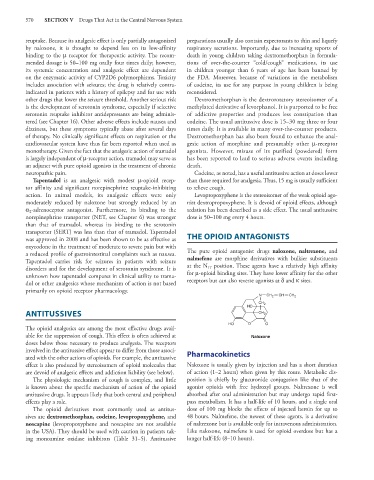Page 584 - Basic _ Clinical Pharmacology ( PDFDrive )
P. 584
570 SECTION V Drugs That Act in the Central Nervous System
reuptake. Because its analgesic effect is only partially antagonized preparations usually also contain expectorants to thin and liquefy
by naloxone, it is thought to depend less on its low-affinity respiratory secretions. Importantly, due to increasing reports of
binding to the μ receptor for therapeutic activity. The recom- death in young children taking dextromethorphan in formula-
mended dosage is 50–100 mg orally four times daily; however, tions of over-the-counter “cold/cough” medications, its use
its systemic concentration and analgesic effect are dependent in children younger than 6 years of age has been banned by
on the enzymatic activity of CYP2D6 polymorphisms. Toxicity the FDA. Moreover, because of variations in the metabolism
includes association with seizures; the drug is relatively contra- of codeine, its use for any purpose in young children is being
indicated in patients with a history of epilepsy and for use with reconsidered.
other drugs that lower the seizure threshold. Another serious risk Dextromethorphan is the dextrorotatory stereoisomer of a
is the development of serotonin syndrome, especially if selective methylated derivative of levorphanol. It is purported to be free
serotonin reuptake inhibitor antidepressants are being adminis- of addictive properties and produces less constipation than
tered (see Chapter 16). Other adverse effects include nausea and codeine. The usual antitussive dose is 15–30 mg three or four
dizziness, but these symptoms typically abate after several days times daily. It is available in many over-the-counter products.
of therapy. No clinically significant effects on respiration or the Dextromethorphan has also been found to enhance the anal-
cardiovascular system have thus far been reported when used as gesic action of morphine and presumably other μ-receptor
monotherapy. Given the fact that the analgesic action of tramadol agonists. However, misuse of its purified (powdered) form
is largely independent of μ-receptor action, tramadol may serve as has been reported to lead to serious adverse events including
an adjunct with pure opioid agonists in the treatment of chronic death.
neuropathic pain. Codeine, as noted, has a useful antitussive action at doses lower
Tapentadol is an analgesic with modest μ-opioid recep- than those required for analgesia. Thus, 15 mg is usually sufficient
tor affinity and significant norepinephrine reuptake-inhibiting to relieve cough.
action. In animal models, its analgesic effects were only Levopropoxyphene is the stereoisomer of the weak opioid ago-
moderately reduced by naloxone but strongly reduced by an nist dextropropoxyphene. It is devoid of opioid effects, although
α -adrenoceptor antagonist. Furthermore, its binding to the sedation has been described as a side effect. The usual antitussive
2
norepinephrine transporter (NET, see Chapter 6) was stronger dose is 50–100 mg every 4 hours.
than that of tramadol, whereas its binding to the serotonin
transporter (SERT) was less than that of tramadol. Tapentadol
was approved in 2008 and has been shown to be as effective as THE OPIOID ANTAGONISTS
oxycodone in the treatment of moderate to severe pain but with
a reduced profile of gastrointestinal complaints such as nausea. The pure opioid antagonist drugs naloxone, naltrexone, and
Tapentadol carries risk for seizures in patients with seizure nalmefene are morphine derivatives with bulkier substituents
disorders and for the development of serotonin syndrome. It is at the N position. These agents have a relatively high affinity
17
unknown how tapentadol compares in clinical utility to trama- for μ-opioid binding sites. They have lower affinity for the other
dol or other analgesics whose mechanism of action is not based receptors but can also reverse agonists at δ and κ sites.
primarily on opioid receptor pharmacology.
N CH 2 CH CH 2
CH 2
HO
ANTITUSSIVES CH 2
HO O O
The opioid analgesics are among the most effective drugs avail-
able for the suppression of cough. This effect is often achieved at Naloxone
doses below those necessary to produce analgesia. The receptors
involved in the antitussive effect appear to differ from those associ- Pharmacokinetics
ated with the other actions of opioids. For example, the antitussive
effect is also produced by stereoisomers of opioid molecules that Naloxone is usually given by injection and has a short duration
are devoid of analgesic effects and addiction liability (see below). of action (1–2 hours) when given by this route. Metabolic dis-
The physiologic mechanism of cough is complex, and little position is chiefly by glucuronide conjugation like that of the
is known about the specific mechanism of action of the opioid agonist opioids with free hydroxyl groups. Naltrexone is well
antitussive drugs. It appears likely that both central and peripheral absorbed after oral administration but may undergo rapid first-
effects play a role. pass metabolism. It has a half-life of 10 hours, and a single oral
The opioid derivatives most commonly used as antitus- dose of 100 mg blocks the effects of injected heroin for up to
sives are dextromethorphan, codeine, levopropoxyphene, and 48 hours. Nalmefene, the newest of these agents, is a derivative
noscapine (levopropoxyphene and noscapine are not available of naltrexone but is available only for intravenous administration.
in the USA). They should be used with caution in patients tak- Like naloxone, nalmefene is used for opioid overdose but has a
ing monoamine oxidase inhibitors (Table 31–5). Antitussive longer half-life (8–10 hours).

